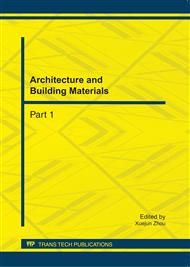p.960
p.965
p.972
p.977
p.982
p.988
p.994
p.1000
p.1005
Research on the Relation between the Mechanical Parameter and Water Content about the Synthetic Geotechnical Simulation Material
Abstract:
The physical simulation test of similar material is one of the most common research techniques in the geotechnical domain. Because the experimental finding of physical simulation is directly affected by the physical mechanical property and stability of similar material, then selecting the fitting formulation, mixture ration and water content of the similar material for different investigated subjects to get the ideal similar material is the most attentive problem during the experiment. After researching the variational compressive strength and tensile strength with the water content of the synthetic material which is made of sand, cement, gesso with two mixed rations, the relation of second-degree parabola between the main mechanical parameter and the water content of the synthetic material is obtained, and the optimal rate of water content which can make the similar material reach the maximal compressive strength or tensile strength is obtained
Info:
Periodical:
Pages:
982-987
Citation:
Online since:
September 2011
Authors:
Price:
Сopyright:
© 2011 Trans Tech Publications Ltd. All Rights Reserved
Share:
Citation:


